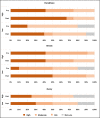Psychosocial outcome and health behaviour intent of breast cancer patients with BRCA1/2 and PALB2 pathogenic variants unselected by a priori risk
- PMID: 35167615
- PMCID: PMC8846504
- DOI: 10.1371/journal.pone.0263675
Psychosocial outcome and health behaviour intent of breast cancer patients with BRCA1/2 and PALB2 pathogenic variants unselected by a priori risk
Abstract
There is an increasing number of cancer patients undertaking treatment-focused genetic testing despite not having a strong family history or high a priori risk of being carriers because of the decreasing cost of genetic testing and development of new therapies. There are limited studies on the psychosocial outcome of a positive result among breast cancer patients who are at low a priori risk, particularly in women of Asian descent. Breast cancer patients enrolled under the Malaysian Breast Cancer Genetic Study between October 2002 and February 2018 were tested for BRCA1, BRCA2 and PALB2 genes. All 104 carriers identified were invited by a research genetic counsellor for result disclosure. Of the 104 carriers, 64% (N = 66) had low a priori risk as determined by PENN II scores. Psychosocial, risk perception and health behaviour measures survey were conducted at baseline (pre-result disclosure), and at two to six weeks after result disclosure. At baseline, younger carriers with high a priori risk had higher Cancer Worry Scale scores than those with low a priori risk but all scores were within acceptable range. Around 75% and 55% of high a priori risk carriers as well as 80% and 67% of low a priori risk carriers had problems in the "living with cancer" and "children" psychosocial domains respectively. All carriers regardless of their a priori risk demonstrated an improved risk perception that also positively influenced their intent to undergo risk management procedures. This study has shown that with sufficient counselling and support, low a priori risk carriers are able to cope psychologically, have improved perceived risk and increased intent for positive health behaviour despite having less anticipation from a family history prior to knowing their germline carrier status.
Conflict of interest statement
The authors have declared that no competing interests exist.
Figures




Similar articles
-
Association of a Polygenic Risk Score With Breast Cancer Among Women Carriers of High- and Moderate-Risk Breast Cancer Genes.JAMA Netw Open. 2020 Jul 1;3(7):e208501. doi: 10.1001/jamanetworkopen.2020.8501. JAMA Netw Open. 2020. PMID: 32609350 Free PMC article.
-
Timing of genetic testing in BRCA1/2 and PALB2-Associated breast cancer: Preoperative result disclosure increases uptake of risk-reducing mastectomy and reduces unnecessary exposure to radiotherapy.Eur J Surg Oncol. 2024 Jun;50(6):108324. doi: 10.1016/j.ejso.2024.108324. Epub 2024 Apr 12. Eur J Surg Oncol. 2024. PMID: 38636249
-
Prevalence and spectrum of germline rare variants in BRCA1/2 and PALB2 among breast cancer cases in Sarawak, Malaysia.Breast Cancer Res Treat. 2017 Oct;165(3):687-697. doi: 10.1007/s10549-017-4356-8. Epub 2017 Jun 29. Breast Cancer Res Treat. 2017. PMID: 28664506 Free PMC article.
-
Frequency of heterozygous germline pathogenic variants in genes for Fanconi anemia in patients with non-BRCA1/BRCA2 breast cancer: a meta-analysis.Breast Cancer Res Treat. 2020 Jul;182(2):465-476. doi: 10.1007/s10549-020-05710-6. Epub 2020 Jun 2. Breast Cancer Res Treat. 2020. PMID: 32488392
-
[PALB2, a major susceptibility gene for breast cancer].Gynecol Obstet Fertil Senol. 2018 Nov;46(10-11):701-705. doi: 10.1016/j.gofs.2018.08.006. Epub 2018 Sep 19. Gynecol Obstet Fertil Senol. 2018. PMID: 30243941 Review. French.
Cited by
-
Anxiety and disease awareness in individuals with heredity for abdominal aortic aneurysm.J Med Screen. 2025 Jun;32(2):67-75. doi: 10.1177/09691413241278224. Epub 2024 Sep 9. J Med Screen. 2025. PMID: 39248023 Free PMC article.
References
-
- Owens DK, Davidson KW, Krist AH, Barry MJ, Cabana M, Caughey AB, et al.. Risk Assessment, Genetic Counseling, and Genetic Testing for BRCA-Related Cancer: US Preventive Services Task Force Recommendation Statement. Jama. 2019;322(7):652–65. Epub 2019/08/21. doi: 10.1001/jama.2019.10987 . - DOI - PubMed
-
- Domchek SM, Aghajanian C., Shapira-Frommer R., Schmutzler R. K., Audeh M. W., Friedlander M., et al.. Efficacy and safety of olaparib monotherapy in germline BRCA1 / 2 mutation carriers with advanced ovarian cancer and three or more lines of prior therapy. Gynecologic Oncology. 2016;140(2):199–203. doi: 10.1016/j.ygyno.2015.12.020 - DOI - PMC - PubMed
Publication types
MeSH terms
Substances
Grants and funding
LinkOut - more resources
Full Text Sources
Medical
Research Materials
Miscellaneous

